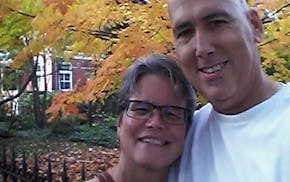It was a crow that first caught Frank Glick's attention. It was flying around erratically, so Glick got out his Nikon camera and followed it. It was around 6 a.m. on a hazy spring day and he was driving through Fort Snelling National Cemetery because he was early for a training meeting at Delta Airlines, where he works.
Glick is an amateur photographer, but he always carries his camera, just in case. So he followed the crow, in some cultures a symbol of good luck and magic, until he saw it: a huge eagle perched on a tombstone, its eyes alert, its head craned, looking for prey. In the foreground, dew glistened on the grass.
Glick got his shot.
He didn't think too much about the photo, until he showed it to a co-worker, Tom Ryan, who e-mailed it to his brother, Paul.
Paul wondered whether a relative of the soldier might want a copy. The tail of the eagle partially covered the man's name, but Paul did some research and looked up the soldier's name in newspaper obituaries. The eagle had landed on the grave of Sgt. Maurice Ruch, who had been a member of the St. Anthony Kiwanis Club, the obituary said.
Paul called the club, and it put him in touch with Jack Kiefner, Ruch's best friend. When Glick took his photo, he never could have guessed how much it was going to mean to Kiefner and Ruch's widow, Vivian.
One day this week, I met with Kiefner and Vivian Ruch in her St. Anthony condo. The actual print would be delivered later that day, but Vivian held a copy of the statuesque photo and her voice broke as she talked about Maurie, his nickname, who died from a form of Parkinson's in 2008 at age 86.
"I'm sorry," she said. "This is very emotional for me."
Maurie graduated from college in mechanical engineering in December of 1941 and enlisted in the U.S. Army Air Corps. Known for his keen eye, he became a rifle marksman and was stationed in the Aleutian Islands. He served four years in the military and earned a bronze star.
To those who knew Maurie, he was a calm and deliberate giant. He stood 6 feet, 4 inches tall, with broad shoulders, but he was also unassuming and unpretentious.
"Used to call him Mr. Precise," because of his love of order and knack for fixing things, said Vivian. The Ruches had a rotary telephone long after they became obsolete because Maurie scavenged parts and kept the phone working.
"He could work a slide rule like nobody else," said Kiefner, who was a manager at Honeywell when Maurie was there as an engineer. Kiefner and Maurie were friends for more than 60 years. Not many people can say that anymore.
Maurie also loved nature and photography, so "he would have absolutely loved this picture," Vivian said. "I told him his first love was his rifle."
On a rainy morning, Vivian spread photos of Maurie in the service, and the two old friends sat and ate banana bread and talked about a man they both loved.
They got that opportunity because a guy they didn't know, Frank Glick, caught a special moment, and he and his friends took the time to seek them out and share the photo.
I told Vivian that some cultures believe the eagle is a symbol, not only of patriotism and dignity, but a messenger between heaven and earth. She nodded solemnly.
"I'd say the eagle had a very good eye when he landed on Maurie, and he was respected," she said.
"I miss him," said Vivian as she picked up the photo. "He was a good man and a good provider."
"The eagle couldn't have picked a better person," said Kiefner. He paused. "This has been kind of fun hasn't it?"
Tears welled in Vivian's eyes.
"Yes, it's been wonderful."
jtevlin@startribune.com • 612-673-1702

Tevlin: 'Against all odds, I survived a career in journalism'

Tevlin: Grateful Frogtown couple fight their way back from fire and illness



